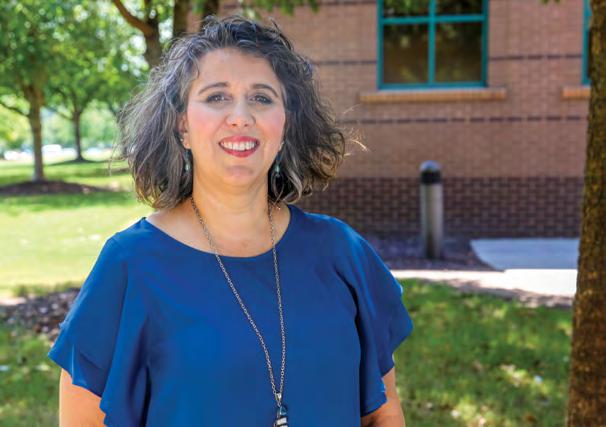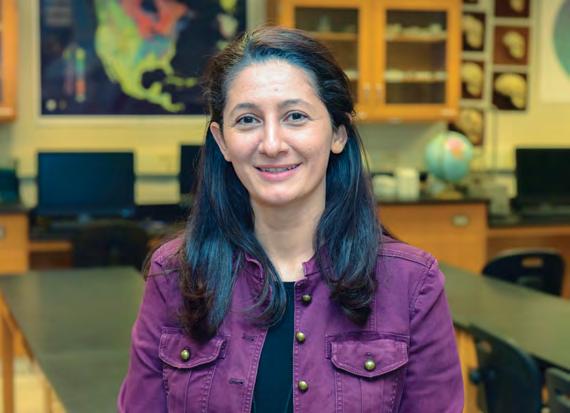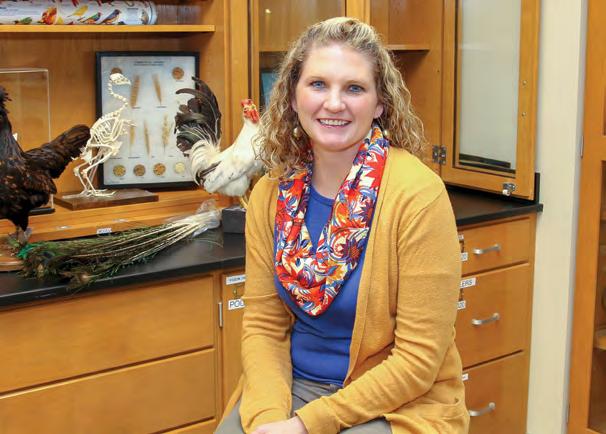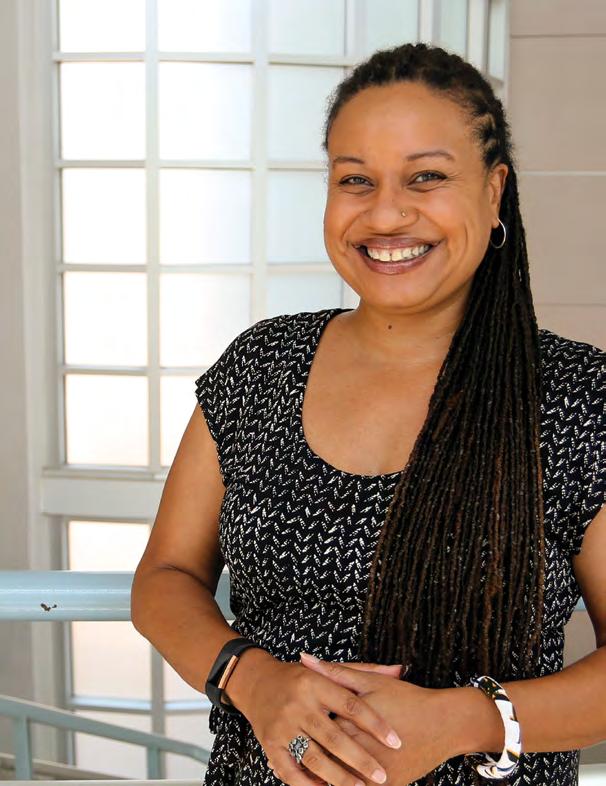
15 minute read
Women in STEM
SCIENCE TECHNOLOGY ENGINEERING MATHEMATICS
Inspiring leaders in science, technology, engineering & mathematics
Advertisement
By Edie Rogers Photos by Peggy Cozart
Do you know a UNG woman who is inspiring others in STEM? Let us know and she may be considered for a future profile. Email universityrelations@ung.edu
According to statistics from the National Science Foundation (NSF), women remain underrepresented in the workforce in the areas of science, technology, engineering and mathematics (STEM). Though half of the college-educated workforce in the U.S. is female, women only account for 28% of the workforce employed in science and engineering.
In higher education, the number of women taking STEM courses and pursuing degrees in scientific fields is increasing, but overall in the U.S. programs like computer sciences and engineering are overwhelmingly male-dominated, according to the NSF.
At UNG, a number of faculty, staff, alumnae, and students who are successful in the field are actively mentoring and encouraging students and other women in STEM. As the beginning of an occasional series to be shared through UNG’s Where I Lead website, UNG Magazine profiles eight inspiring Women in STEM.
Dr. Allison Bailey
Associate professor of environmental studies and geography in the Lewis F. Rogers Institute for Environmental and Spatial Analysis (IESA)
Accomplishments
Instrumental in UNG’s Tree Campus USA designations; $100,000 EPA grant to manage native and invasive vegetation for healthy forests and waterways for a two-year timeframe
Areas of Expertise
Environmental communication, geospatial technologies, nature education, community engagement, collaboration with environmental nonprofit organizations

Education:
Ed.D. in higher education administrative leadership, Argosy University; graduate certificate in geographic information systems, University of West Georgia; M.A. in speech communication, University of Louisiana at Monroe; B.A. in English education with a minor in history, University of Louisiana at Monroe
Dr. Allison Bailey knows the struggles of succeeding as a professional in the male-dominated industry, and she has become a member of an organization geared toward helping similar faculty improve and succeed as a TRELIS fellow, an NSF-funded professional development program for women in the geospatial sciences in higher education.
TRELIS awarded her a grant to conduct a professional development workshop for women in the geosciences in Georgia, and she collaborated with professors from the University of Georgia and Valdosta State University to facilitate the one-day workshop during the fall 2018 semester. "I was really honored to receive this," Bailey said, explaining she attended a three-day conference in Madison, Wisconsin, that helped her evaluate her professional life and choices. "I figured out what I wanted for my career and how to make decisions to lead me in the direction I want to go."
Bailey chairs the Georgia Geospatial Technical Advisory Committee, which provides guidance on standards for geospa tial data used by government agencies and industries statewide. She chairs the Education Committee for Georgia URISA, the state professional association for geospatial sciences, and coordinates the Georgia K-12 geospatial competition.
Accomplishments
S-STEM Scholar; recipient of German Academic Exchange Service Research Internships in Science and Engineering (RISE) scholarship to intern at the Max Planck Institute for Solar System Research in Germany

Jessica Hamilton
Undergraduate student pursuing a degree in physics
For some, “staring into space” is a figure of speech, but for 31-year-old Jessica Hamilton, it has a literal meaning. She is studying starspots, which are caused by magnetic fields. Her research on the topic with a fellow physics major led to a presentation at the 20th Cambridge Workshop on Cool Stars, Stellar Systems and the Sun in Boston.
That experience helped Hamilton stand out among applicants to earn an internship at a prestigious German research institute. She was one of 300 international students selected for the RISE scholarship from more than 1,900 who applied. Hamilton interned at the Max Planck Institute for Solar System Research in Göttingen, Germany.
“The internship at the Max Planck Institute expanded my cultural horizons, my international contacts, and my base knowledge in the realm of astrophysics,” said Hamilton, who lives in Dahlonega, Georgia, with her 5-year-old daughter. “I returned from the experience with a greater knowledge of what sub-field I want to focus on for my career path and what it will entail.”
Katayoun Mobasher
Professor of geology in the Lewis F. Rogers Institute for Environmental and Spatial Analysis (IESA) and geosciences coordinator
Accomplishments
Multiple publications and presentations of research in her areas of specialty and in education; several grants, including Innovative Teaching Program Project Grant and Presidential Incentive Awards; active in mentoring student projects in programs such as UNG’s Inaugural Student Start-Up FUSE program
Areas of expertise:
Petrology, structural geology, GIS, remote sensing

Education:
Ph.D. in chemistry with concentration in structural geology, Georgia State University; M.S. in petrology, Azad University; B.S. in geology, Shahid Beheshti University
Dr. Katayoun Mobasher, who began her academic career in 2001 as a teaching assistant at Georgia State University, has been with UNG for more than 11 years. She believes geology is a key part of life and works to provide an innovative learning experience for her students.
“Every day we hear about some aspect of geology in the news – such as earthquake activities, volcanic eruptions, oil supplies, threats from landslides, and water supply contaminations,” she said. “I hope my students gain an appreciation of geology around them and learn how earth processes and materials affect our lives and the ways humans affect the Earth. I want them to understand that we must be responsible for the Earth and its continuous growth and sustainability.”
Mobasher, who is interested in interdisciplinary studies that combine her various areas of expertise, enjoys both the challenges and rewards of finding new ways to teach. She’s developed new methods and activities to keep her students engaged, including through use of technology in the classroom and the field. She also figured out how to teach a very visual concept – topographical maps – to a visually impaired student by working with colleagues to create tactile maps.
Mobasher is also very active in the community often providing presentations and speaking engagements to local organizations such as the Elachee Nature Science Center, the Atlanta Geological Society, U.S. Geological Survey, and the Gainesville Newcomers Group.
Dr. Linda Purvis
Assistant professor of biology/poultry science, alumna
Accomplishments Ann Matthews Purdy Outstanding UNG Faculty Award 2016; Teaching Excellence Award 2016; restarted poultry program from which she had graduated; Young Alumni Achievement Award from UGA’s College of Agricultural and Environmental Sciences 2018
Areas of Expertise
Poultry science, infectious diseases, virology, immunology

Education
Ph.D. in science education, University of Georgia; M.S. in infectious disease, University of Georgia; B.S. in poultry science, University of Georgia; A.S. in poultry science, UNG
Dr. Linda Purvis, ’00, who grew up on a poultry farm, decided in eighth or ninth grade she wanted to study poultry science. After earning three degrees in the field, she returned in 2011 to then-Gainesville State College where she earned her associate degree years prior. She had a specific task in mind: to rebuild from scratch a poultry science program that had not been taught in more than a decade.
“I had a chicken skeleton. That was about it. No resources, no textbooks, nothing,” she said. “I wanted to build that program back up, and the biology department here was very encouraging and wanted that to happen.”
Through her connections with the University of Georgia’s poultry program and relationships she formed with the poultry industry, Purvis acquired funding, including grants and scholarships, to make the poultry science program a reality. UNG offers an Associate of Science in Core Curriculum with pathway courses related to agriculturepoultry science that is a perfect fit for students who seek to go into the industry or business-related careers in agriculture. Classes in the program include accounting, economics, microbiology, and multiple courses related to poultry production and evaluation.
“I’m really passionate about helping students figure out what they’re really good at and helping them find a job and a career that will fit that,” Purvis said.
Dr. Miriam Segura-Totten
Professor of biology, Harry B. Forester Eminent Scholars Chair
As a high school student in Puerto Rico, Miriam Segura-Totten thought she would attend a college on the island after graduation. Her mother, however, had different ideas and encouraged her to apply to schools located on the U.S. mainland.
“I got into Princeton University. I chose to attend there because it had a good community of Puerto Ricans. It was beautiful and looked like nowhere that I had been before,” she said.
While many postgraduates go into research fields, Segura-Totten veered into academe. She wanted to mentor and inspire students, just like she was.
“Mentoring students is having those conversations … about finding their passions and pursuing them,” she said.
Segura-Totten has succeeded there. In 2017, she won an Inspiring Leaders in STEM award from INSIGHT Into Diversity magazine. The award is based on a professor’s efforts to inspire and encourage a new generation of young people to consider careers in STEM through mentoring, teaching, research, and successful programs and initiatives.

Accomplishments
“Inspiring Leader in STEM,” INSIGHT Into Diversity magazine; Regents’ Award for Excellence in Teaching; UNG Distinguished Teaching Award; research funding from National Institutes of Health, the American Association for the Advancement of Science, and others
Areas of Expertise
Cell biology, molecular biology, scholarship of teaching and learning
Education
Ph.D. in biochemistry, cell and molecular biology, Johns Hopkins
School of Medicine;
B.A. in molecular biology, Princeton University
Head of Department of Mathematics, professor of mathematics

Dianna Spence turned a weakness in the area of mathematics into a strength and then a passion through the support of her mother and a number of mentors. Spence’s learning specialist mother discovered through a series of tests that young Dianna was not strong in math and set out to increase her skills through drills and games. Spence later found high school math came easy and she was asked to tutor her fellow students.
Always interested in becoming a teacher, Spence initially taught computer science after college and then spent some time working in the computer industry as a software engineer at a time when few were women and customers weren’t used to that.
While Spence said respect for women in STEM has progressed, she seeks to support her fellow female faculty and female students by sharing her experiences and the advice of her mentors.
“I told my grad school professor, whose main field of research was self-efficacy, that I had a little bit of that ‘impostor syndrome’ because I was in the class with all of these really smart people and I wasn’t sure I was one of them,” Spence said. “He told me, ‘Everybody feels that way. That’s how everyone who gets to that level of success feels.’ He was very clear to me about how I needed to ignore that and just push through.”
Areas of Expertise
Statistics education; data science; statistical programming; discrete mathematics; graph theory
Education
Ph.D. in mathematics education, Emory University; M.S. in computer science, Georgia State University; B.A. in mathematics, William & Mary University
Accomplishments
Co-primary investigator and primary investigator for two multiyear NSF grants on statistics education; co-inventor on two software patents; 19 peer-reviewed publications and more than 60 conference presentations during UNG career
Accomplishments
S-STEM Scholar; recipient of National Science Foundation (NSF) Research Experience for Undergraduates (REU) at Florida State University

Emily Storck
Undergraduate student pursuing a chemistry degree
As Emily Storck transitioned from dual enrollment, a program that allows eligible high school students to take college courses tuition-free and earn high school and college credit, to attending UNG as a regular student she knew she needed a way to cover the costs. The S-STEM Scholars program provided the answer.
“It has allowed me to work fewer jobs outside of school and focus more on getting the grades needed to get into graduate school, and different experiences that also help such as working as a teaching assistant for the chemistry department and doing research for multiple semesters,” Storck said.
Funded at UNG through the NSF, the program aims to increase the STEM workforce. The competitive scholarship provides annual $4,362 stipends to each student in the program, plus additional funds to support their research.
Storck said the program has opened doors for research, conferences and graduate school. The senior from Buford, Georgia, pursuing a degree in chemistry got an earlier start on her research than most students thanks to S-STEM. Her research seeks to improve chemistry labs for UNG students.
Storck also was selected for an NSF Research Experience for Undergraduates (REU) to research light and matter with a Florida State University faculty member for 10 weeks.
New Blue Ridge Campus opening fall 2020

By Clark Leonard
In the mountains of Fannin County, UNG’s new standalone Blue Ridge Campus is taking shape.
The roads have been paved, utilities have been installed, and site grading and construction began this fall. The campus is scheduled to be completed in time for fall 2020 classes.
The new campus is located off Ga. Hwy. 515, about three miles from the current Blue Ridge Campus.
Georgia Speaker of the House of Representatives David Ralston helped secure $5.5 million in state funds for the new Blue Ridge Campus in the 2019 fiscal year budget. A UNG alumnus, Ralston represents Georgia District 7, including Fannin County, in the General Assembly.
“I’m excited to see this important project move forward. The new Blue Ridge Campus will make permanent the availability of a world-class college education in our community,” Ralston said. “As one of the region’s top public universities — and consistently ranked as one of the best values in higher education — UNG will afford students better job prospects and attract new businesses to our north Georgia mountains for generations to come.”
Sandy Ott, director of UNG’s Blue Ridge Campus, said science lab space, a computer lab and spaces for students to gather and study outside of classrooms are important elements in the new campus’ design. Access to science labs will expand course offerings to allow students to finish
specific degree paths in Blue Ridge.
“From the beginning of the planning process for the new campus, the focus has been on our students,” Ott said. “This new campus aligns with the university’s access mission and allows UNG to provide outstanding quality and an affordable higher education opportunity for this region; it is truly a game-changer.”
The Blue Ridge Campus opened with 20 students in 2015, and enrollment this fall is 199 students,

Ott said. The design leaves the opportunity for future growth, including another building, more parking and sidewalks.
Ott is grateful for the support of students, faculty, staff, and the community for the Blue Ridge Campus.
“This community is invested in this campus and our students,” Ott said. “The future is very bright for the UNG’s Blue Ridge Campus.”
UNG established the campus in response to a need for access to
An artist's rendering of the Blue Ridge Campus depicts the campus entrance, building and ample greenspace.
higher education that was identified through UNG’s Regional Education and Economic Development Task Force, a group of more than 100 business, education, government, and community leaders from northeast Georgia. The new location will further cement UNG’s efforts to advance educational attainment in the region.
Where I Lead: Diversity in Education
BIO

DR. LAUREN JOHNSON, department head for the Department of Culture, Language and Leadership in the College of Education and associate professor of teacher education at UNG, has worked alongside her colleagues in the College of Education on UNG’s partnership with Gainesville and Hall County schools to train the next generation of diverse teachers.
Johnson, coordinator of diversity and recruitment initiatives for the College of Education, was a 2019 Diversity Champion Award winner for these efforts.
What inspired you to become an educator?
I first told my mother I wanted to be a teacher sometime around eighth grade. I have always loved to learn and did my best to excel in school. I think I have always thought teaching to be a noble profession and decided that I could make the greatest impact as an educator. Now, I am inspired by my amazing students who have the same professional goals. They teach me just as much as I teach them.
What did you gain from the Fulbright-Hays Seminar Abroad Program and the Governor’s Teaching Fellows program in 2017?
The Fulbright-Hays summer program provided me the opportunity to work with other educators from around the country in learning more about Chile, including its culture, sociopolitical issues, and education system. It was an honor to have been selected for the opportunity and a delight to explore Chile with new friends and colleagues. The Governor’s Teaching Fellows program was a brief yet impactful experience to learn more high-impact teaching practices, technological tools, and assessment strategies for use in the university classroom.
How have partnerships with area schools helped UNG prepare more students of color to be teachers?
Through our efforts to recruit and train successful graduates of Hall County high schools and current Gainesville City paraprofessionals, we have hopefully provided necessary support for students who might otherwise be unable to achieve their goals of becoming teachers. This partnership provides financial assistance in addition to mentorship, advisement, and social activities that we plan to help the cohort bond and offer support. Through these programs, we are encouraging more students of color to become teachers with the eventual goal of producing highly effective educators who will go on to make positive contributions in their local communities. Our graduates will have jobs waiting for them when they complete their degrees.

Why is it important to have teachers who are people of color?
Representation matters. Research shows that students respond well to teachers who share their cultural, linguistic and religious backgrounds. Students of color are no longer a minority in this country and, therefore, their teachers should be more representative of their communities. This is clear when we consider the educational experiences of non-native English speakers in U.S. schools; our increasingly diverse population necessitates that teachers effectively communicate with students and parents in their own languages. The best way to present the range of educational opportunities and career paths available to young people of color is to provide them examples in their schools of all that they can achieve.


